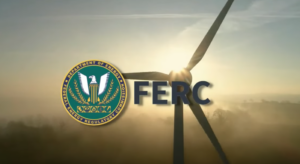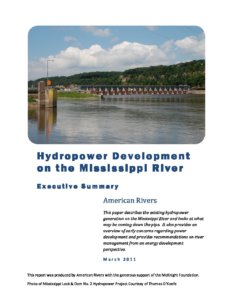Klamath River Dam Removal Takes an Important Step Forward (OR/CA)

The Federal Energy Regulatory Commission (FERC) has just released a final Environmental Impact Statement (FEIS) which recommends the removal of four hydroelectric dams on the Klamath River. This is the final step of analysis, and a federal decision to authorize removal of the dams is expected later this year, with dam removal taking place in 2024. This would be the largest dam removal project in the world.
In addition to responding to and addressing comments on the Draft EIS that was released earlier this year, the FEIS represents a comprehensive review of all of the benefits and impacts of the proposed dam removal project. According to the FEIS, “Project removal and implementation of mitigation measures proposed in management plans would protect environmental resources, restore project lands, minimize adverse effects, maximize benefits to protected fish, and restore the landscape of the areas that are currently impounded within the project reach to a more natural state. Commission staff recommends approval of the proposed license surrender, decommissioning and removal of the project with staff additional recommendations and mandatory conditions.”
American Whitewater has long supported the removal of the J.C. Boyle, Copco 1, Copco 2, and Iron Gate Dams on the Klamath River. These dams have environmental, water quality, and social justice impacts that greatly exceed the value of the minimal power they produce. In addition to benefits to the fishery resource and the indigenous communities that depend on them, restoring the river will open up new opportunities for whitewater boating and improve water quality that routinely threatens public health during the late summer. Although scheduled dam releases for the Hells Corner run will cease and affect summertime boating on that reach, new opportunities will emerge with flows restored to the Big Bend reach below J.C. Boyle Dam and Wards Canyon below the Copco dams. Based on the results of a 2020 study to assess the impacts of dam removal on whitewater boating, we anticipate boaters will be able to enjoy longer journeys down the river during the spring boating season and kayakers and smaller rafts will be able to boat various segments into or through the summer months. Wards Canyon in particular is an incredibly scenic stretch of the Klamath River that has been dewatered and inaccessible for the past century. It will see restored flows suitable for rafting and kayaking year round.
We are pleased that FERC staff responded to our comments and addressed the following whitewater-related issues in the FEIS:
- Removal of boating hazards in the Big Bend run where remaining construction material that contributes to hazardous boating conditions at Sidecast Slide and in Ward’s Canyon where vegetation has encroached the riverbed over the past century that the river channel has been dewatered by dams;
- Developing a plan for funding the construction and maintenance of the river access sites described in the dam removal plan to include, at a minimum, construction of access facilities that would be located in areas that would be affected by land disturbance during implementation of the proposed action;
- Consulting with American Whitewater and Upper Klamath Outfitters Association to schedule dam removal activities and access restrictions to minimize adverse effects on whitewater boaters.
Thank you to our members and supporters who filed comments with FERC supporting dam removal and the mitigation measures for whitewater recreation we requested. Your voice made a difference.
The next step in this process is for the FERC to finalize the decision on dam removal. Based on the findings of the FEIS, we expect this approval will come in the coming months and will provide the final authorization for dam removal to proceed. The current plan is for reservoir drawdown to begin late in 2023 and the actual removal of all four dams to take place during 2024. Boaters will be able to experience a restored river in 2025. We support the efforts of Ríos to Rivers and their Paddle Tribal Waters program that is teaching and empowering Native youth to be the first to kayak the soon to be undammed Klamath River.
BACKGROUND INFORMATION:
Download and Read the FEIS:
https://elibrary.ferc.gov/eLibrary/filelist?accession_num=20220826-3006
Excerpts from the FEIS of Particular Interest to Whitewater Boaters:
FERC Analysis of River Recreation, Section 3.7.3.2 of FEIS:
After removal of the project dams, flatwater reservoir reaches would become free-flowing reaches, and the bypassed and peaking reaches would have a more normative flow regime.
Interior and California DFG (2012) conducted hydrologic modeling to assess changes in the availability of acceptable whitewater boating flows. In the bypassed reaches at J.C. Boyle and Copco No. 2, there would be a substantial increase in the number of days with flows acceptable to whitewater boaters (table 3.7-6). These reaches have historically had minimal or reduced flows during hydropower operations, and a return to more normative flow conditions would create opportunities for whitewater boating. The changes in flow regime in the flow regime in the bypassed reaches would have a permanent, significant, beneficial effect on whitewater recreation.
In the Hell’s Corner reach, the number of days with flows acceptable to whitewater boaters would decrease (table 3.7-6). Flows through this reach are currently sustained by hydropower peaking energy production, allowing whitewater boating from April through October. The greatest demand for recreation boating occurs during the months of July, August, and September, the driest period of the year with low natural streamflows. The Hell’s Corner reach is currently the only Class IV+ rapids in the region with late summer boatable flows. Following dam removal, the number of boatable days between 1,000 and 1,500 cfs would be reduced by an estimated 43 percent, and the number of boatable days with flows between 1,300 and 3,500 cfs would be reduced by 57 percent (table 3.7-6), which would result in a permanent, significant, and unavoidable adverse effect on whitewater river users of the Hell’s Corner reach.
The removal of the project reservoirs would eliminate the slow-moving habitat in the reservoirs which is preferred by toxin-producing Microcystis and seasonal releases of dissolved nutrients from the reservoir bottom waters to downstream reaches of the Klamath River. This would reduce the potential for noxious phytoplankton growth in the reach below Iron Gate Dam (section 3.3.3.3) and improve water quality. The improved water quality would provide a permanent beneficial effect for recreational boaters in the reaches below Iron Gate Dam.
River recreation opportunities are expected to increase substantially the former reservoir and bypassed reaches (table 3.7-7; figure 3.7-7), benefiting regional outfitters and recreation boaters. This would result in a permanent, beneficial effect for whitewater boating in these reaches.
To address previous stakeholder concerns regarding the hazardous conditions at Sidecast Slide, PacifiCorp removed debris in the river at Sidecast Slide in 2012. The recreation flow study in 2020 concluded that boating conditions at Sidecast Slide improved following this work, although the site is still considered hazardous for recreation boaters at lower flows (Confluence Research and Consulting, 2021).
Breaking up selected boulders at the Sidecast Slide and removing selected trees in the active channel of the Copco No. 2 bypassed reach would reduce hazards to whitewater boaters and make these reaches more accessible to experienced boaters. Implementing these measures prior to reservoir drawdown would allow the work to be completed under controlled flow conditions, making the work more efficient while minimizing adverse effects. These measures would have a permanent, significant, beneficial effect on recreation by enhancing boater safety at these locations and eliminating the need for portages.
KRRC’s proposal to consult with UKOA to determine how construction activities prior to reservoir drawdown and dam removal can be planned and scheduled to maintain reasonable access to established boat launch and take-out sites would reduce adverse effects on whitewater boaters and outfitters. Staff also recommend including American Whitewater in this consultation because they represent the general boating public. While construction activities would still have a temporary, significant, adverse effect on recreation access, these effects would be reduced with this consultation.
KRRC’s proposal to develop river access sites during deconstruction and restoration activities would avoid additional ground disturbance and associated adverse effects that would occur if their development was deferred until after license surrender. Development of the sites during deconstruction and restoration would also likely result in a cost savings relative to constructing the sites at a later date.
FERC Analysis of River Access, Section 3.7.3.2 of FEIS:
KRRC, with the support of American Whitewater, has identified new river access sites designed to support boating on the whitewater reaches that would become available following project decommissioning. Most of these sites are located on lands that are intended to be transferred in ownership from PacifiCorp to the States of Oregon and California after decommissioning is completed.
KRRC’s proposal to revise the Recreation Facilities Plan in cooperation with the States of Oregon and California, to specify an approach to secure funding for the construction of additional access sites would reduce the time it would take for these sites to be developed and open to the public. Development of new river access sites in the former reservoir reaches would have a permanent, significant, beneficial effect on recreation opportunities (both whitewater and other river-based recreation activities), both regionally and locally.
By Thomas O’Keefe
This post originally appeared on www.americanwhitewater.org.


